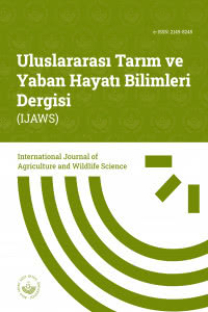Domateste (Solanum lycopersicum L.) Dışsal IAA Uygulamalarının Tuza Tolerans Üzerindeki Etkisi
Bitki büyüme düzenleyicisi, Indol-3 asetik asit, oksin, Solanacae
Effects of The Exogenous IAA Applıcatıons on Salt Tolerance in Tomato (Solanum lycopersicum L.)
Auxin, ındole-3-acetic acid, plant growth regulator, Solanacae,
___
- Abd El-Samad, H. M. (2013). The physiological response of wheat plants to exogenous application of gibberellic acid (GA3) or indole-3-acetic acid (IAA) with endogenous ethylene under salt stress conditions. International Journal of Plant Physiology and Biochemistry, 5, 58-64. https://doi.org/10.5897/IJPPB12.016
- Abdel Latef, A. A. H., Tahjib-Ul-Arif, M., & Rhaman, M. S. (2021). Exogenous auxin- mediated salt stress alleviation in faba bean (Vicia faba L.). Agronomy, 11, 547. https://doi.org/10.3390/agronomy11030547
- Alam, M., Khan, M. A., Imtiaz, M., Khan, M. A., Naeem, M., Shah, S. A., & Khan, L. (2020). Indole-3-acetic acid rescues plant growth and yield of salinity stressed tomato (Solanum lycopersicum L.). Gesunde Pflanzen, 72, 87-95. https://doi.org/10.1007/s10343-019-00489-z
- Dasgan, H.Y., & Koc, S. (2009). Evaluation of salt tolerance in common bean genotypes by ion regulation and searching for screening parameters. Journal of Food, Agriculture Environment, 7, 363-372.
- Dasgan, H.Y., Bayram, M., Kusvuran, S., Coban, G., & Akhoundnejad, Y. (2018). Screening of tomatoes for their resistance to salinity and drought stress. Journal of Biology, Agriculture and Healthcare, 8, 31-37.
- Eren Guzelgun, B., Ince, E., & Gurer-Orhan, H. (2018). In vitro antioxidant/prooxidant effects of combineduse of flavonoids. Natural Product Research, 32, 1446-1450. https://doi.org/10.1080/14786419.2017.1346637
- Es-Safi, N. E.,Ghidouche, S., & Ducrot, P.H. (2007). Flavonoids: hemisynthesis, reactivity, characterization and free radical scavenging activity. Molecules, 12, 2228-2258. https://doi.org/10.3390/12092228
- Husen, A., Iqbal, M., & Aref, I. M. (2016). IAA-induced alteration in growth and photosynthesis of pea plants grown under salt stress Pisum sativum. Journal of Environmental Biology, 37, 421-429.
- İşlek, C., Koç, E., & Sülün Üstün, A. (2010). Biber (Capsicum annuum L.) tohumlarında bazı bitki büyüme düzenleyicilerinin in vitro çimlenme üzerine etkisi. Balıkesir Üniversitesi Fen Bil. Enst. Dergisi, 12, 42-49.
- Jovanović, S. V.,Kukavica, B., Vidović, M., Morina, F., & Menckhoff, L. (2018). Class III Peroxidases: functions, localization and redox regulation of isoenzymes. In: D.K. Gupta, J.M. Palma, & F.J. Corpas (Eds.) Antioxidants and antioxidant enzymes in higher plants (pp. 269-300). Springer, Cham.
- Kaya, C., Tuna, A. L., Dikilitas, M., & Cullu, M. A. (2010). Responses of some enzymes and key growth parameters of salt-stressed maize plants to foliar and seed applications of kinetin and indole acetic acid. Journal of Plant Nutrition, 33, 405-422. https://doi.org/10.1080/01904160903470455
- Kaya, C., & Okant T.A. (2013) Effect of foliar applied kinetin and indole acetic acid on maize plants grown under saline conditions. Turkish Journal Agriculture and Forestry, 34, 529–538. https://doi.org/10.3906/tar-0906-173
- Khalid, A., & Aftab, F. (2020). Effect of exogenous application of IAA and GA3 on growth, protein content, andantioxidant enzymes of Solanum tuberosum L. grown in vitro under salt stress. In Vitro Cellular & Developmental Biology-Plant, 1-13. https://doi.org/10.1007/s11627-019-10047-x
- Kumlay, A. M., & Eryiğit, T. (2011). Bitkilerde büyüme ve gelişmesini düzenleyici maddeler: bitki hormonları. Iğdır Üniversitesi Fen Bilimleri Enstitüsü Dergisi, 1, 47-56.
- Kuşvuran, A., Kiran, S.U., Nazlı, R.I., & Kusvuran S. (2015). Morphological response and ion regulation in maize (Zea mays L.) varieties under salt stress. Fresenius Environmental Bulletin, 24, 124-131.
- Kusvuran, S., Kıran, S., & Altuntas, O. (2021). Influence of salt stress on different pepper genotypes: Ion homeostasis, antioxidant defense, and secondary metabolites. Global Journal of Botanical Science, 9, 14-20.
- Liang, W., Ma, X., Wan, P., Liu, L. (2018). Plant salt-tolerance mechanism: A review. Biochemical and Biophysical Research Communications, 495, 286-291. https://doi.org/10.1016/j.bbrc.2017.11.043
- Molina-Quijada, D. M. A., Medina-Juárez, L. A., González-Aguilar, G. A., Robles-Sánchez, R. M., & Gámez-Meza, N. (2010). Phenolic compounds and antioxidant activity of table grape (Vitis vinifera L.) skin from northwest Mexico. CyTA-Journal of Food, 8, 57-63.
- Michalak, A. (2006). Phenolic compounds and their antioxidant activity in plants growing under heavy metal stress. Polish Journal of Environmental Studies, 15, 523-530.
- Nielsen, S. S. (2017). Sodium determination using ion-selective electrodes, Mohr titration, and test strips. In S.S. Nielsen (Eds.), Food Analysis Laboratory Manual (pp. 161-170). Springer, Cham.
- Ünlükara, A., Cemek, B., & Karadavut, S. (2006). Farklı çevre koşulları ile sulama suyu tuzluluğu ilişkilerinin domatesin büyüme, gelişme, verim ve kalitesi üzerindeki etkileri. Gaziosmanpaşa Üniversitesi Ziraat Fakültesi Dergisi, 23, 15-23.
- Yang, Y., & Guo, Y. (2018). Elucidating the molecular mechanisms mediating plant salt‐stress responses. New Phytologist, 217, 523-539. https://doi.org/10.1111/nph.14920
- Yılmaz, E., Tuna, A., & Bürün, B. (2011). Bitkilerin tuz stresi etkilerine karşı geliştirdikleri tolerans stratejileri. Celal Bayar University Journal of Science, 7, 47–66.
- ISSN: 2149-8245
- Yayın Aralığı: 3
- Başlangıç: 2015
- Yayıncı: BOLU ABANT İZZET BAYSAL ÜNİVERSİTESİ > ZİRAAT VE DOĞA BİLİMLERİ FAKÜLTESİ
Hasan AKAY, Elif ÖZTÜRK, İsmail SEZER, Mehmet Sait KİREMİT, Hakan ARSLAN, Bhaskara Anggarda Gathot SUBRATA
Soya (Glycine max L.)’da PGPR ve AMF Uygulamalarının Verim Özellikleri ve Protein İçeriğine Etkisi
Hakkı Ekrem SOYDEMİR, Abdurrahim YILMAZ, Vahdettin ÇİFTÇİ, Hilal YILMAZ
Ramazan CANHİLAL, Çetin MUTLU, Hasan Utku İNCE
Türkiye’de Sığır Yetiştiricilerinin Irk Tercihleri ve Nedenleri
İsa YILMAZ, Onur ŞAHİN, Ali KAYGISIZ
İlker KURŞUN, Başak AYDIN, Mehmet Ali GÜRBÜZ, Erol ÖZKAN, Emel KAYALI, Volkan ATAV, İhsan Engin KAYHAN
Sadık Emre GÖRÜR, Ferda YARPUZLU, Bülent ALTAN, Doğancan KAHYA, Abdurrahman YİĞİT, Mehmet KARACAOĞLU, Halil KÜTÜK
Akkeçi Dişi Oğlaklarının Erken Damızlıkta Kullanılma Olanakları
